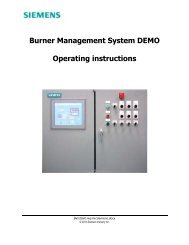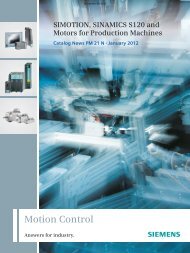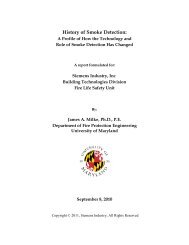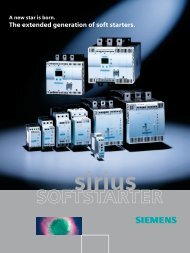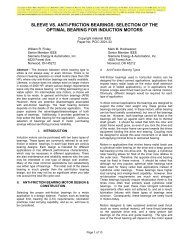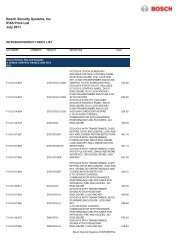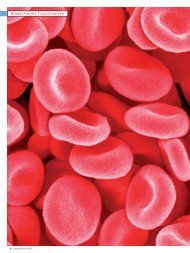SIMATIC PROFIBUS technology components - Siemens Industry, Inc.
SIMATIC PROFIBUS technology components - Siemens Industry, Inc.
SIMATIC PROFIBUS technology components - Siemens Industry, Inc.
Create successful ePaper yourself
Turn your PDF publications into a flip-book with our unique Google optimized e-Paper software.
<strong>SIMATIC</strong><br />
<strong>PROFIBUS</strong> <strong>technology</strong> <strong>components</strong><br />
Brochure · November 2005<br />
s
Technology <strong>components</strong> for <strong>PROFIBUS</strong> DP<br />
Introduction<br />
Introduction<br />
For manufacturers flexible and<br />
economic production is the<br />
only way of ensuring that<br />
products meet the rapidly<br />
changing needs of the customer.<br />
Distributed automation<br />
structures are one of the factors<br />
needed for flexible and<br />
economic production. The<br />
required flow of information is<br />
ensured by interconnecting<br />
the various areas of the system<br />
over local area networks.<br />
In the field of industrial communications, networks complying<br />
with national and international standards enable the<br />
exchange of information at all levels of the automation<br />
hierarchy.<br />
<strong>PROFIBUS</strong> DP fieldbus<br />
The <strong>PROFIBUS</strong> DP fieldbus has become established at the field<br />
level, where a high-speed response is required and small<br />
amounts of data are generally exchanged.<br />
<strong>PROFIBUS</strong> DP is an open fieldbus system and is standardized to<br />
European and international standards. This fieldbus system is<br />
also the basis for <strong>PROFIBUS</strong> PA, the fieldbus for process automation.<br />
Features<br />
The <strong>PROFIBUS</strong> DP fieldbus is characterized by the following<br />
features:<br />
■ Corresponds to IEC 61158-3, Ed. 2<br />
■ Comprehensive range of fieldbus <strong>components</strong><br />
■ Data transmission via two-wire (RS 485) or<br />
fiber optic system<br />
■ Flexible and modular design of the automation system<br />
possible<br />
■ Connection to actuator-sensor interface possible<br />
■ Reduction in wiring overhead<br />
■ Up to 125 nodes can be connected with<br />
up to 32 per bus segment<br />
■ Short response times thanks to transmission rates<br />
of up to 12 Mbit/s<br />
■ Coverage of distances up to 23.8 km/14.7 miles<br />
■ Simple connection of devices through the availability<br />
of ASICs and interface modules<br />
■ <strong>PROFIBUS</strong> DP is the system bus for<br />
Totally Integrated Automation<br />
■ Leading PLC vendors recognize <strong>PROFIBUS</strong> DP as a<br />
standard interface for the field level.<br />
ASICs and interface modules<br />
The full documentation of the interface to the <strong>PROFIBUS</strong> DP<br />
fieldbus is available.<br />
The ASICs and interface modules described below provide<br />
third-party vendors with a simple and cost effective interface<br />
design for connecting their devices and systems to<br />
<strong>PROFIBUS</strong> DP.<br />
Various ASICs and interface modules are available for different<br />
functional needs (master function, both simple and intelligent<br />
slave stations).<br />
ASICs and interface modules are described on the following<br />
pages.<br />
PROFINET<br />
PROFINET is the new open Industrial Ethernet Standard for<br />
industrial automation. With it, devices can be linked from the<br />
field level up to the operations management level. In addition,<br />
PROFINET permits simple integration of existing fieldbus systems,<br />
e.g. the widely used <strong>PROFIBUS</strong>.<br />
There will also be technological <strong>components</strong> for PROFINET in<br />
the future – development kits and ASICs for PROFINET are<br />
currently being prepared (see Product Brief on PROFINET<br />
<strong>technology</strong> <strong>components</strong>).<br />
Lead-free<br />
Two new European directives (2002/95/EG - RoHS,<br />
2002/96/EG - WEEE) prohibit the use of <strong>components</strong> containing<br />
lead in many electric and electronic devices for environmental<br />
protection reasons as of 01.07.2006.<br />
Although programmable controllers are not covered by these<br />
directives in the current statute document, we will also offer<br />
the <strong>PROFIBUS</strong> ASICs as lead-free versions. Through this we<br />
want to permit our customers to develop environmentally<br />
friendly products.<br />
2 Technology <strong>components</strong> for <strong>PROFIBUS</strong> DP
Fieldbus<br />
<strong>PROFIBUS</strong> DP, <strong>PROFIBUS</strong> PA<br />
Application<br />
<strong>PROFIBUS</strong> is the bus system for the field and cell areas.<br />
Two versions are available for the various demands:<br />
■<br />
■<br />
<strong>PROFIBUS</strong> DP<br />
<strong>PROFIBUS</strong> PA.<br />
Master devices<br />
S7-400<br />
Programming<br />
device<br />
ET 200pro<br />
<strong>PROFIBUS</strong> DP<br />
<strong>PROFIBUS</strong> DP<br />
The <strong>PROFIBUS</strong> DP fieldbus features high-speed communication<br />
with small amounts of data and high system availability.<br />
It corresponds to the IEC 61158 standard with the DP protocol<br />
variant. In addition, <strong>PROFIBUS</strong> DPV1 is the basis for<br />
<strong>PROFIBUS</strong> PA.<br />
ET 200M<br />
HMI<br />
ET 200S<br />
DP/PA-Link<br />
<strong>PROFIBUS</strong> PA<br />
<strong>PROFIBUS</strong> PA is the <strong>PROFIBUS</strong> version for process automation.<br />
<strong>PROFIBUS</strong> PA uses transmission <strong>technology</strong> in accordance with<br />
IEC 1158-2. This transmission process can also be used for<br />
intrinsically safe applications. The communication protocols<br />
of <strong>PROFIBUS</strong> PA and <strong>PROFIBUS</strong> DP are identical. <strong>PROFIBUS</strong> DP<br />
communication protocol + IEC-1158-2 transmission <strong>technology</strong><br />
= <strong>PROFIBUS</strong> PA.<br />
Design<br />
<strong>PROFIBUS</strong> DP is different for active bus participants and<br />
passive bus participants.<br />
Active nodes (master)<br />
■ Programmable controllers, e.g. S7-300/S7-400<br />
■ PC-based Control Systems, e.g. WinAC<br />
■ <strong>SIMATIC</strong> programming devices and PCs<br />
■ HMI devices<br />
■ Machine controllers, e.g. SINUMERIK<br />
■ Control systems, e.g. SIMADYN<br />
■ Third-party PLCs<br />
Passive nodes (slaves)<br />
■ Distributed I/O stations <strong>SIMATIC</strong> ET 200<br />
■ Controllers, e.g. S7-200/S7-300<br />
■ Field devices such as drives or<br />
human-machine interface units<br />
■ Field devices of process <strong>technology</strong>, e.g. SITRANS<br />
■ Third-party field devices<br />
The <strong>PROFIBUS</strong> DP fieldbus can be installed in two-wire cable<br />
(RS 485), fiber optic or hybrid configurations.<br />
Slave devices<br />
SITRANS P<br />
<strong>PROFIBUS</strong> PA<br />
Mode of operation<br />
The nodes in the network share the transmission medium.<br />
A system is therefore required to control access to the network.<br />
<strong>PROFIBUS</strong> DP operates according to the “master/slave token<br />
passing” access method, whereby only active nodes receive<br />
the right access the network. The right to access is transferred<br />
by passing a token from one master to the next. If there is no<br />
request to send, the token is passed on to the next master. The<br />
passive bus nodes are polled directly by the master module<br />
assigned to them.<br />
Open interfaces for <strong>PROFIBUS</strong> DP/<strong>PROFIBUS</strong> PA<br />
The communication performance required for the short<br />
response times cannot be achieved using the usual standard<br />
<strong>components</strong>. <strong>Siemens</strong> has therefore developed several highperformance<br />
ASICs for interfacing the <strong>PROFIBUS</strong> DP. These<br />
ASICs handle a significant proportion of the communication.<br />
The interface modules supplied for master and slave applications<br />
are based on these ASICs.<br />
<strong>PROFIBUS</strong> Support Centers<br />
The Support Centers support field device manufacturers prior<br />
to and during the development, and carry out the required certification<br />
tests. In addition, they provide further information<br />
on the ASICs, interface modules and development kits.<br />
See page 12 for addresses.<br />
<strong>PROFIBUS</strong> International<br />
<strong>PROFIBUS</strong> International (PNO), which represents users and<br />
manufacturers of <strong>PROFIBUS</strong> products, provides e.g. a platform<br />
for co-operation and exchange of information.<br />
<strong>PROFIBUS</strong> International (PNO)<br />
Haid-und-Neu-Straße 7<br />
D-76131 Karlsruhe<br />
Fax: +49/721/96 58 589<br />
www.profibus.com<br />
Fieldbus 3
<strong>PROFIBUS</strong> ASICs<br />
Overview<br />
Application<br />
The <strong>PROFIBUS</strong> ASICs facilitate the connection of third-party<br />
<strong>components</strong> and systems to the <strong>PROFIBUS</strong> fieldbus. Quick<br />
response times for the <strong>PROFIBUS</strong> DP, which are required for<br />
transmission rates of up to 12 Mbit/s, can only be achieved<br />
by using these ASICs. Various ASICs are available for different<br />
functional needs and applications.<br />
Master ASICs<br />
The ASPC 2 (Advanced <strong>Siemens</strong> <strong>PROFIBUS</strong> Controller) is an<br />
intelligent communications chip for master applications<br />
(DP, DPV1, DPV2). This ASIC is suitable for use in master interface<br />
modules for connection to <strong>PROFIBUS</strong> DP. The maximum<br />
transmission rate is 12 Mbit/s.<br />
Master<br />
applications<br />
Intelligent<br />
slave<br />
applications<br />
Simple<br />
slave<br />
applications<br />
ASPC2<br />
FOCSI<br />
<strong>PROFIBUS</strong> DP<br />
SPC3<br />
LSPM2<br />
RS 485<br />
SPC<br />
4-2<br />
DPC<br />
31<br />
<strong>PROFIBUS</strong> PA<br />
IEC 1158-2<br />
SIM<br />
1<br />
Intelligent slave ASICs<br />
The SPC 3 (<strong>Siemens</strong> <strong>PROFIBUS</strong> Controller) is an intelligent<br />
communications block for intelligent slave applications (DPV1<br />
without interrupts), and permits connection to <strong>PROFIBUS</strong> DP.<br />
The maximum transmission rate is 12 Mbit/s. The SPC 4-2 also<br />
supports <strong>PROFIBUS</strong> PA. An external microprocessor is additionally<br />
required to operate the SPC 3.<br />
Slave ASIC with processor core<br />
The DPC31 combines the functions of the SPC 3, SPC 41 and<br />
an 8031 processor in one chip (DPV1, DPV2). The DPC31 is a<br />
DP slave controller whose flexibility allows extremely versatile<br />
use. The DPC31 with its low power management is also designed<br />
for use in hazardous areas. It permits connection to<br />
<strong>PROFIBUS</strong> DP and <strong>PROFIBUS</strong> PA.<br />
The DPC31 with the SIM 1-1 offers an integral compact solution<br />
for connection to <strong>PROFIBUS</strong> PA with a transmission procedure<br />
according to IEC 1158-2. The maximum transmission rate<br />
is 12 Mbit/s for <strong>PROFIBUS</strong> DP and 31.25 kbit/s for <strong>PROFIBUS</strong> PA.<br />
Simple slave ASICs<br />
The LSPM 2 is also a single-chip solution for simple slave applications.<br />
As a result of its small housing, it is particularly suitable<br />
for applications where space is limited. The maximum<br />
transmission rate is 12 Mbit/s.<br />
ASICs for signal conditioning and<br />
conversion to other media<br />
These ASICs function as supplements to existing <strong>PROFIBUS</strong><br />
ASICs. They convert the signals into other media/transmission<br />
forms or condition the signals.<br />
The SIM1-1 (<strong>Siemens</strong> Medium Attachment Unit) is required for<br />
signal adaptation to <strong>PROFIBUS</strong> PA.<br />
The FOCSI (Fiber Optical Controller from <strong>Siemens</strong>) provides<br />
appropriate electrical conditioning and transfer of the<br />
received/sent optical signal. In order to link the signal into a<br />
fiber-optic cable, corresponding optical transmitters and<br />
receivers are required in addition to the FOCSI.<br />
4 <strong>PROFIBUS</strong> ASICs
Operation<br />
The ASICs handle a large part of the communications tasks<br />
between the bus node and the network.<br />
The LSPM 2 handles all communications tasks completely independently.<br />
The correct signals only need to be applied to the<br />
pins. An additional processor or firmware is not required.<br />
The ASICs of the SPC range (SPC 3, SPC 41, DPC31 and ASPC 2)<br />
are equipped with a processor interface. They require additional<br />
firmware for the interface between the ASIC and the<br />
application.<br />
Firmware<br />
The firmware is installed in a processor on the interface<br />
module or in the field device. The functions of the field device<br />
are included via the call interface. The scope of the firmware<br />
depends on the ASIC.<br />
Delivery arrangements<br />
The ASICs can be obtained through the worldwide distribution<br />
network of <strong>Siemens</strong> AG. Quantities of six ASICs can be ordered<br />
for testing. For series production, only multiples of an ASIC<br />
packaging unit (tray) are possible. The number of ASICs per<br />
package depends on the type of ASIC.<br />
Documentation<br />
The descriptions of the <strong>technology</strong> <strong>components</strong> are available<br />
for downloading free of charge at<br />
www.ad.siemens.de/csi/dp<br />
under the title<br />
■<br />
Distributed I/O / Technology Components / Manuals<br />
<strong>PROFIBUS</strong> ASICs 5
<strong>PROFIBUS</strong> ASICs<br />
LSPM 2<br />
Application<br />
The ASIC LSPM 2 (Lean <strong>Siemens</strong> <strong>PROFIBUS</strong> Multiplexer) is a<br />
single-chip solution for simple slave applications. Examples<br />
include sensors and actuators such as switches and indicators.<br />
The ASIC enables connection of these simple digital input/output<br />
devices to the <strong>PROFIBUS</strong> DP fieldbus. The smaller package<br />
makes the LSPM 2 particularly suitable for use in applications<br />
where space is at a premium.<br />
The maximum transmission rate is 12 Mbit/s. The IM 184 interface<br />
module is implemented with the ASIC LSPM 2.<br />
Design<br />
The LSPM 2 has 32 input/output bits. It is accommodated in a<br />
MQFP package with 80 pins.<br />
The subdivision of the input/output points into inputs and outputs<br />
is configurable. Pins are also provided on the ASICs for<br />
diagnostic information.<br />
The LSPM 2 handles the complete data traffic independently.<br />
An additional microprocessor and firmware are not required.<br />
It is thus possible, using a small number of external <strong>components</strong>,<br />
to implement a simple connection to the <strong>PROFIBUS</strong> DP<br />
fieldbus.<br />
Operation<br />
The LSPM 2 handles the bus protocol fully independently. The<br />
pins only need to be connected to the input/output signals and<br />
bus cables.<br />
The LSPM 2 operates as slave on the <strong>PROFIBUS</strong> DP network.<br />
When they receive an error-free message frame from the master,<br />
they generate the requested reply frames independently.<br />
<strong>PROFIBUS</strong> DP<br />
RS485 driver with<br />
electrical isolation<br />
Quartz<br />
Jumper<br />
Reset<br />
LSPM2<br />
Diagnostics<br />
Ports<br />
EPROM<br />
Socket<br />
Example of integration of the ASIC LSPM 2 in a slave application<br />
Features<br />
■ <strong>PROFIBUS</strong> DP protocol<br />
■ Maximum transmission rate 12 Mbit/s<br />
■ Automatic detection of transmission rate<br />
■ RS 485 transmission protocol<br />
■ MQFP package with 80 pins<br />
■ Integrated ASIC circuit (glue logic)<br />
■ 32 input/output bits, of which up to 16 diagnostics inputs<br />
■ 8 separate diagnostics inputs<br />
■ User-specific allocation of input/output points to inputs and<br />
outputs<br />
■ Integrated watchdog timer<br />
■ External quartz port for<br />
24 MHz and 48 MHz quartz/oscillator<br />
■ 5 V DC power supply<br />
■ Suitable for implementation of simple digital input/output<br />
modules<br />
Male connector for bus system<br />
Firmware<br />
No firmware is required for operation of the LSPM 2. The entire<br />
protocol handling is performed by the LSPM 2.<br />
6 <strong>PROFIBUS</strong> ASICs
SPC 3 and SPC 4-2<br />
<strong>PROFIBUS</strong> DP<br />
RS485 driver with<br />
electrical isolation<br />
48 MHz<br />
clock<br />
SPC 3<br />
INT<br />
Data and<br />
address bus<br />
Micro processor<br />
WR/RD<br />
Reset<br />
Reset<br />
Example of integration of the ASIC SPC 3 in a slave application<br />
Male connector for bus system<br />
Features<br />
SPC 3, SPC 4-2<br />
■ Protocols: <strong>PROFIBUS</strong> DP, DPV1 (without interrupts), DPV 2<br />
■ Maximum transmission rate 12 Mbit/s<br />
■ Automatic determination of transmission rate<br />
■ Microprocessor support: 80C32, 80X86, 80C166, 80C165,<br />
80C167 as well as HC11, HC16 and HC916 types<br />
■ RS 485 transmission mode<br />
■ PQFP housing with 44 pins<br />
■ Automatic handling of communications functions<br />
including the <strong>PROFIBUS</strong> DP protocol<br />
■ Integral watchdog timer<br />
■ External connection for 48-MHz crystal oscillator<br />
■ 5 V DC power supply<br />
Application<br />
SPC 3, SPC 4-2<br />
The ASICs SPC 3 and SPC 4-2 are intelligent communications<br />
blocks for intelligent slave applications. They allow connection<br />
even of complex slave devices to the <strong>PROFIBUS</strong> DP fieldbus.<br />
The IM 183-1 interface module is implemented with the SPC 3.<br />
The maximum transmission rate is 12 Mbit/s.<br />
ASIC SPC 4-2 is very similar to the SPC 3 with respect to application,<br />
design, mode of operation and features.<br />
Design<br />
SPC 3<br />
The SPC 3 has a 1.5-KB message memory. It is located in a<br />
PQFP housing with 44 pins.<br />
SPC 4-2<br />
The SPC 4-2 has a 3-KB message memory.<br />
Special feature of SPC 4-2<br />
■ <strong>PROFIBUS</strong> PA with low power and synchronous interface<br />
Firmware<br />
Firmware (source code in "C") is available as the interface<br />
between the SPC registers and the application.<br />
The firmware executes on the field device’s processor, and offers<br />
call interfaces for simple incorporation of the application.<br />
The firmware can also be used for the IM 182-1 and IM 183-1<br />
interface modules.<br />
The firmware is not essential for operation of the SPC 3 with<br />
the standard DP functions since the registers of the ASICs are<br />
exactly documented. However, the firmware means that users<br />
can save the required development work.<br />
The firmware is required to use the enhanced DP functions<br />
DPV1 (read/write data record).<br />
Operation<br />
The SPC 3/SPC 4-2 automatically handles all communications<br />
tasks of the <strong>PROFIBUS</strong> DP protocol. This means that protocol<br />
processing is significantly faster. In addition, the amount of<br />
software in the interface module’s microprocessor is reduced.<br />
Bus access is hardware-based. The data transfer is by means of<br />
a 1.5-KB or 3 KB RAM. The interface to the application is designed<br />
as a data interface. This permits temporary decoupling<br />
from the bus.<br />
To permit convenient operation with the microprocessor, firmware<br />
is available with call interfaces for the application.<br />
<strong>PROFIBUS</strong> ASICs 7
Communications chip<br />
DPC31<br />
Application<br />
DPC31 combines the different features of the ASICs SPC 3 and<br />
SPC 4-2 in one chip, which means that this chip is suitable for<br />
a wide range of applications. The DPC 31 is an intelligent communications<br />
chip with an integrated processor core. It allows<br />
intelligent field devices to be connected to the <strong>PROFIBUS</strong> DP.<br />
Because of the power management system and the 3.3 V <strong>technology</strong>,<br />
the DPC 31 can also be used in process <strong>technology</strong> in<br />
connection with the <strong>PROFIBUS</strong> PA. The DPC 31 allows a slave<br />
application to be realized with minimal expenditure on external<br />
<strong>components</strong>.<br />
Design<br />
In order to be connected to the physical bus, the DPC 31 not<br />
only has an asynchronous interface for the RS485 interface,<br />
but also has a synchronous interface to the SIM1. This interface<br />
allows the DPC 31 to be connected to the synchronous<br />
transmission <strong>technology</strong> of the IEC 1158-2 structure, which<br />
uses <strong>PROFIBUS</strong> PA, via an energy-saving interface.<br />
The DPC31 has a 6-KB RAM as message memory and an integral<br />
8031 core together with 24-KB firmware ROM, packed in<br />
a PQFP housing with 100 pins.<br />
Operation<br />
The DPC 31 handles the entire DP slave protocol independently<br />
and relieves the application from all time-critical communication<br />
functions. All the necessary timer and monitoring<br />
functions are integrated in the DPC 31.<br />
The interface to the application is made up of 6 Kilobytes of<br />
RAM, through which the application communicates with the<br />
communication part of the DPC 31. The interface takes the<br />
form of a data interface. Firmware with a call interface is also<br />
provided to facilitate operation with an external processor.<br />
The integrated 8031 core is 100% compatible to standard<br />
8031 derivatives. This means that all standard developing<br />
environments can be used for programming and debugging.<br />
256 bytes of ‘internal’ RAM and the ‘timer 2’ of the 8032<br />
derivatives are added to the integrated 8031 core, meaning<br />
that a genuine 8032 controller is available in the DPC 31.<br />
The firmware ROM for the 8031 core has the following<br />
functions:<br />
■<br />
■<br />
■<br />
Read and write functions for SPI compatible E 2 PROM<br />
Boot loader for single-chip applications<br />
All system functions necessary for the realization of a<br />
‘DP slave’.<br />
Block diagram of the DPC31<br />
The DPC 31 offers the following operation options:<br />
■<br />
■<br />
■<br />
Bus and boot type<br />
setting, reset<br />
Register cells<br />
6 KB<br />
communications<br />
and code RAM<br />
Micro sequencer<br />
SPC3<br />
DPC31<br />
27 pin I/O-Port or<br />
external uP interface<br />
multi functional<br />
I/O interface<br />
Multiport RAM<br />
controller<br />
Physical unit<br />
asynch.<br />
<strong>PROFIBUS</strong><br />
interface<br />
synch.<br />
SPI interface<br />
SSC module<br />
ROM<br />
24 KB<br />
PLL +<br />
clock unit<br />
Clkout 1/2<br />
Clkout 1/4<br />
DPC31 as single-chip applications<br />
DPC31 with external ROM/RAM<br />
DPC31 with external microprocessor<br />
4 ports and<br />
special functions<br />
8031-I/O-Interface<br />
(emulator port)<br />
Standard 8031 core<br />
with 256 byte RAM<br />
and additional<br />
timer 2<br />
12 MHz crystal or<br />
direct supply<br />
Test and power supply pins<br />
Features<br />
■ <strong>PROFIBUS</strong> DP/DPV1/DPV2 protocol<br />
■ Maximum transmission rate 12 Mbit/s, using transmission<br />
method IEC 1158-2 31.25 kbit/s<br />
■ Automatic detection of transmission rate<br />
■ Asynchronous Interface according to <strong>PROFIBUS</strong> DP<br />
■ Synchronous interface according to <strong>PROFIBUS</strong> PA<br />
■ Integrated 8031 core<br />
■ SSC interface to connect SPI compatible <strong>components</strong>,<br />
such as E 2 PROMs or AD converters<br />
■ Standard 8031 interface<br />
■ External Intel and Motorola microprocessor interface<br />
■ Supply voltage 3.3 V DC<br />
■ PQFP housing with 100 pins<br />
Firmware<br />
There is firmware (source code in "C") for the DPC31 which<br />
makes using the component even simpler. The firmware is run<br />
on the processor of the field device and offers a simple function<br />
interface for simple linking of the application.<br />
8 <strong>PROFIBUS</strong> ASICs
Medium Attachment Units<br />
SIM 1-1 and FOCSI<br />
Application<br />
The SIM 1-1 (<strong>Siemens</strong> IEC Medium Attachment Unit) matches<br />
the signals for the connection of field devices to IEC 1158-2<br />
and thus also to <strong>PROFIBUS</strong> PA.<br />
<strong>PROFIBUS</strong> PA is the <strong>PROFIBUS</strong> version for process automation.<br />
The transmission process matches IEC 1158-2, the communication<br />
protocol is <strong>PROFIBUS</strong> DP.<br />
<strong>PROFIBUS</strong> PA can also be used for intrinsically safe applications.<br />
Design<br />
The SIM 1-1 is an expansion of the DPC31 or SPC 4-2. Only a<br />
few external <strong>components</strong> are required in addition to this ASIC,<br />
in order to connect <strong>PROFIBUS</strong> PA field devices to an intrinsically<br />
safe network.<br />
The SIM 1-1 is accommodated in a TQFP housing with 44 pins.<br />
Operation<br />
The SIM 1-1 supports all send and receive functions as well as<br />
the high-resistance tapping of the auxiliary power from the<br />
bus cable. It provides 2 stabilized power supplies and enables<br />
the installation of a galvanically isolated power supply. It can<br />
be connected to all IEC 1158-2 compliant Manchester<br />
encoders/decoders.<br />
<strong>PROFIBUS</strong> PA<br />
Bus voltage 9…32 V<br />
Clock<br />
SIM 1-1<br />
TxS<br />
RxS<br />
3,3 V DC<br />
5 V DC<br />
Clock<br />
DPC 31<br />
or<br />
SPC 4-2<br />
Data and<br />
Address bus<br />
Example of integration of the ASICs SPC 4-2 or DPC31<br />
with SIM 1-1 in a slave application<br />
INT<br />
Micro processor<br />
(optional<br />
when using<br />
DPC 31)<br />
WR/RD<br />
Reset<br />
Reset<br />
Features<br />
■ IEC 1158-2 compliant and thus <strong>PROFIBUS</strong> PA compliant<br />
transmission method<br />
■ Transmission rate is 31.25 kbit/s<br />
■ TQFP housing with 44 pins<br />
■ Extraction of auxiliary power of 3.3 V DC and 5 V DC or<br />
5 V DC and 6.6 V DC (power loss up to 250 mW)<br />
■ Power consumption from the fieldbus to supply the unit<br />
can be set to up to 40 mA<br />
■ Integrated low power management<br />
FOCSI for fiber-optic cables<br />
The FOCSI (Fiber Optical Controller from <strong>Siemens</strong>) provides<br />
appropriate electrical conditioning and transfer of the<br />
received/sent optical signal when using fiber-optic cables for<br />
<strong>PROFIBUS</strong> DP. In order to link the signal into a fiber-optic cable,<br />
corresponding optical transmitters and receivers are required<br />
in addition to the FOCSI. The block can be used with all listed<br />
<strong>PROFIBUS</strong> DP ASICs.<br />
<strong>PROFIBUS</strong> ASICs 9
Communications chip<br />
ASPC 2<br />
Application<br />
The ASPC 2 is an intelligent communications chip for master<br />
applications. It allows connection to <strong>PROFIBUS</strong> DP and<br />
<strong>PROFIBUS</strong> FMS.<br />
These ASICs are used to off-load communications handling<br />
tasks from programmable controllers, personal computers,<br />
drive controls and human-machine interfaces.<br />
The IM 180 interface module is implemented with ASPC 2.<br />
The maximum transmission rate is 12 Mbit/s.<br />
Design<br />
The ASPC 2 is accommodated in an MQFP 100 housing.<br />
Operation<br />
The ASPC 2 handles the message frame and address codes and<br />
data backup sequences.<br />
The <strong>PROFIBUS</strong> DP and <strong>PROFIBUS</strong> FMS protocols are handled<br />
completely by the firmware.<br />
The ASPC 2 can address an external 1 Mbyte message frame<br />
memory. Bus access is hardware-driven.<br />
A separate microprocessor and the appropriate firmware are<br />
required for operation. The ASPC 2 can be connected easily to<br />
all standard types of processor.<br />
Features<br />
■ <strong>PROFIBUS</strong> DP and <strong>PROFIBUS</strong> FMS protocols<br />
■ Maximum transmission rate 12 Mbit/s<br />
■ RS 485 transmission<br />
■ Up to 125 active and passive nodes can be connected<br />
■ P-MQFP housing with 100 pins<br />
■ 16-bit data bus<br />
■ 1 Mbyte RAM addressable as external communications<br />
memory<br />
■ Services supported:<br />
Ident; request FDL status; SDN; SDA; SRD; SRD with distribution<br />
database; SM services<br />
■ 2 interrupt lines<br />
■ 5 V DC power supply<br />
■ Maximum power loss 0.9 W<br />
<strong>PROFIBUS</strong> DP<br />
RS485 driver with<br />
electrical isolation<br />
ASPC 2<br />
Integration of the ASPC 2 ASIC in a master application<br />
Firmware<br />
The firmware for the ASPC 2 handles the entire protocol processing<br />
and all functions required for a <strong>PROFIBUS</strong> DP master<br />
connection.<br />
The firmware for <strong>PROFIBUS</strong> DP is offered for device vendors<br />
within the framework of a license agreement.<br />
The firmware is suitable for the 80C165 processor and has a<br />
size of approximately 80 KB. It is optionally available as source<br />
code or object code.<br />
Data bus<br />
Adress bus<br />
Dual port<br />
RAM<br />
Flash EPROM<br />
OTP EPROM<br />
80C165<br />
D0-15<br />
A0-13<br />
Male connector for bus system<br />
10 <strong>PROFIBUS</strong> ASICs
Technical specifications<br />
ASICs<br />
ASICs LSPM 2 SPC 3 SPC 4-2<br />
Application Simple slave applications Intelligent slave applications<br />
Transmission <strong>technology</strong> RS 485 RS 485 RS 485<br />
IEC 1158-2<br />
Transmission rate max. 12 Mbit/s 12 Mbit/s 12 Mbit/s<br />
31.25 kbit/s with IEC 1158-2<br />
Automatic detection of transm. rate ■ ■<br />
Protocols <strong>PROFIBUS</strong> DP <strong>PROFIBUS</strong> DP/DPV1 <strong>PROFIBUS</strong> DP/DPV2<br />
Bus access in ASIC in ASIC<br />
Requires microprocessor – ■<br />
Size of firmware Not required 4 ... 24 KB 8 ... 40 KB<br />
(license offer)<br />
Message frame memory – 1.5 KB 3 KB<br />
Power supply 5 V DC 5 V DC 5 V/3.3 V DC<br />
Power loss max. 0.35 W 0.65 W 0.4 W (DP), 0.01 W (PA)<br />
Permissible ambient temperature -40 … +55 °C -40 … +85 °C<br />
Housing MQFP, 80 pin PQFP, 44 pin TQFP, 44 pin<br />
Housing size 4 cm 2 2 cm 2<br />
WEEE/RoHS conformance ■ ■ Available soon<br />
1<br />
) Worst case at full load<br />
ASICs DPC31 SIM 1-1 FOCSI ASPC 2<br />
Application<br />
Intelligent slave<br />
applications<br />
Medium Attachment Unit<br />
Master applications<br />
Transmission <strong>technology</strong> RS 485, IEC 1158-2 IEC 61158-2 Fiber-optic cable RS 485<br />
Transmission rate max.<br />
12 Mbit/s<br />
31.25 kbit/s 12 Mbit/s 12 Mbit/s<br />
31.25 kbit/s with<br />
IEC 1158-2<br />
Automatic detection<br />
■ – –<br />
of transmission rate<br />
Protocols<br />
<strong>PROFIBUS</strong> DP/DPV1, <strong>PROFIBUS</strong> PA – <strong>PROFIBUS</strong> DP<br />
IsoM, DxB<br />
Bus access in ASIC – in ASIC<br />
Requires microprocessor<br />
Depending on application<br />
– ■ ■<br />
Size of firmware 4 … 24 KB not required 80 KB<br />
(license offer)<br />
Message frame memory 6 KB – 1 MB (ext.)<br />
Power supply 3.3 V DC 3.3 V DC 5 V DC<br />
Power loss max.<br />
0.2 W (DP)<br />
0.009 W 0.75 W 0.9 W<br />
5 - 10 mW (PA)<br />
Permissible ambient temperature -40 … +85 °C -40 … +85 °C -40 … +85 °C -40 … +85 °C<br />
Housing PQFP, 100 pin TQFP, 44 pin MQFP, 100 pin<br />
Housing size 4 cm 2 2 cm 2 4 cm 2<br />
WEEE/RoHS conformance ■ Available soon Available soon ■<br />
Technical specifications 11
Interface modules, development kits<br />
Overview<br />
Applications<br />
Various interface modules, based on the <strong>PROFIBUS</strong> DP ASICs<br />
described above, are available for master and slave applications.<br />
<strong>PROFIBUS</strong> DP interface modules provide third-party vendors<br />
with a simple means of connecting their products and systems<br />
to the <strong>PROFIBUS</strong> DP fieldbus.<br />
The advantage of these interface modules is that they obviate<br />
the need to develop an additional external circuit.<br />
Different interface modules are available for various functional<br />
requirements and applications.<br />
Master interface modules<br />
The CP 5613 communications processor enables the connection<br />
of a third-party device as master to <strong>PROFIBUS</strong> DP. The<br />
maximum transmission rate is 12 Mbit/s.<br />
Slave interface modules<br />
The IM 182-1 interface module is a simple PC card for slave<br />
applications. It is designed for PCs with ISA bus. The maximum<br />
transmission rate is 12 Mbit/s.<br />
The IM 183-1 interface module enables the connection of a<br />
third-party device as a slave to <strong>PROFIBUS</strong> DP. The maximum<br />
transmission rate is 12 Mbit/s.<br />
The IM 184 interface module enables the connection of a<br />
simple slave to <strong>PROFIBUS</strong> DP. The maximum transmission rate<br />
is 12 Mbit/s.<br />
Design<br />
The interface modules consist mainly of an ASIC, if necessary,<br />
a microprocessor for protocol handling as well as a memory.<br />
The interface to the host system is implemented using a multirow<br />
connector strip, or the ISA bus or PCI bus.<br />
Operation<br />
The interface modules handle communications tasks between<br />
the bus node (master or slave) and the <strong>PROFIBUS</strong> DP network.<br />
Data exchange between the interface module and the host<br />
system depends on the interface module, i.e. by using a dualport<br />
RAM, the address and data bus, a serial interface or ports.<br />
Master<br />
applications<br />
Intelligent<br />
slave<br />
applications<br />
Simple<br />
slave<br />
applications<br />
IM 182-1<br />
IM 183-1<br />
IM 184<br />
Classification of the interface modules according to application areas<br />
Development kits<br />
The development kits let you develop and test <strong>PROFIBUS</strong><br />
hardware and software applications that use <strong>PROFIBUS</strong> ASICs<br />
or interface modules (IM) (see pages 14 and 15).<br />
The comprehensive hardware and software <strong>components</strong> of<br />
the packets are tuned to one another, and significantly reduce<br />
the development overhead for a <strong>PROFIBUS</strong> device.<br />
The packages feature a functional development environment,<br />
which is able to accept your special hardware and software<br />
requirements. Consequently our <strong>PROFIBUS</strong> know-how is made<br />
available to others.<br />
Our development team will assist and support you in your<br />
development activities. This support is included in the<br />
development kit.<br />
Subsequently you will be able to have your device certified in<br />
one of our specialized integration centers.<br />
Addresses of our Support Centers:<br />
<strong>PROFIBUS</strong> Support Center<br />
COMDeC<br />
Würzburger Str. 121<br />
D-90766 Fürth<br />
Tel.: +49/911/750-2080,Fax: -2100<br />
E-Mail: COMDEC@siemens.com<br />
PROFI Interface Center<br />
One Internet Plaza, PO Box 4991<br />
TN 37602-4991, Johnson City (USA)<br />
Tel.: ++1 (423)-262-2687<br />
Fax: ++1(423)-461-2103<br />
E-Mail: profibus.center@sea.siemens.com<br />
www.sea.siemens.com/pic/default.html<br />
CP 5613<br />
12 Interface modules, development kits
Master interface module<br />
IM 180<br />
Application<br />
The IM 180 interface module enables the connection of a<br />
third-party device as master to <strong>PROFIBUS</strong> DP. The IM 180 interface<br />
module handles the entire bus control independently.<br />
Use of this interface module significantly reduces the communications<br />
load on programmable controllers, personal computers,<br />
drive controls and HMI systems. The maximum transmission<br />
rate is 12 Mbit/s.<br />
Design<br />
The IM 180 interface module consists mainly of an 80C165<br />
microprocessor, the ASPC 2 ASIC, a Flash EPROM and RAM.<br />
The ASPC 2 ASIC is controlled by a 48 MHz oscillator chip.<br />
The interface module is 100 x 100 mm (3.9 x 3.9 in.) in size<br />
and suitable for face-to-face mounting.<br />
For the IM 180 interface module, a carrier board is available.<br />
This board is called IM 181 and can be used as a short ISA card<br />
in a programming device or PC.<br />
Processor<br />
80C165<br />
RxD<br />
TxD<br />
RTS<br />
ASIC<br />
ASPC 2<br />
Data bus<br />
Address bus<br />
Flash-EPROM<br />
256 K x 16<br />
RAM<br />
2 x 128 K x 8<br />
Consistency<br />
control<br />
Dual port<br />
RAM<br />
CS Logic<br />
D0-D15<br />
A0-A13<br />
TxD<br />
RxD<br />
RTS<br />
A0<br />
Male connector for host bus system<br />
Operation<br />
The integrated ASPC 2 ASIC handles the bus protocol fully<br />
independently.<br />
Communication with the host system takes place via a dualport<br />
RAM interface. Data exchange is handled by the user program.<br />
The host software for the power supply of the dual-port RAM<br />
must be created by the user.<br />
Features<br />
■ Maximum transmission rate 12 Mbit/s<br />
■ <strong>PROFIBUS</strong> DP protocol handling by ASPC 2 ASIC<br />
Module core:<br />
- 80C165 microprocessor, 40 MHz clock frequency<br />
- 2 x 128K x 8-bit RAM user memory<br />
- 256K x 16-bit flash EPROM program and parameter<br />
memory<br />
■ 48 MHz oscillator chip for ASPC 2<br />
Host interface:<br />
- 16/ 8-bit data bus can be connected<br />
- dual-port RAM (8K x 16 bit)<br />
- 64-pin connector (4 rows)<br />
- optional 8/16-bit data bus connectable<br />
■ High-integrity data exchange via dual-port RAM<br />
■ 5 V DC power supply<br />
■ 0 to 70 °C permissible ambient temperature<br />
■ Dimensions (W x H): 100 x 100 mm (3.9 x 3.9 inch).<br />
Block diagram for IM 180 master interface module<br />
Firmware<br />
The firmware is operated on the microprocessor and handles<br />
the entire protocol processing as well as all functions required<br />
for a master connection.<br />
Driver<br />
A corresponding driver is offered for Windows NT.<br />
Demonstration software<br />
The demonstration software for the IM 180 / IM 181-1 shows<br />
in exemplary manner how the dual-port RAM under the<br />
MS-DOS operating system of the IM 180 interface module is<br />
supplied and enables different operations of the IM 180 on the<br />
user interface.<br />
Configuring<br />
The IM 180 interface module can be easily configured with<br />
COM <strong>PROFIBUS</strong> configuring software. The user does not have<br />
to create his own configuring tool.<br />
Interface modules, development kits 13
Slave interface modules<br />
IM 184<br />
Application<br />
The IM 184 interface module enables the simple connection of<br />
a third-party device as slave to <strong>PROFIBUS</strong> DP. The maximum<br />
transmission rate is 12 Mbit/s.<br />
The IM 184 is designed for simple slave applications such as<br />
the connection of simple sensors and actuators.<br />
Design<br />
The IM 184 interface module consists mainly of the LSPM 2<br />
ASIC, a socket for the EEPROM and an RS 485 interface for connection<br />
to <strong>PROFIBUS</strong> DP.<br />
LEDs are also provided for the operating states “RUN”,<br />
“BUS ERROR” and “DIAGNOSTICS”.<br />
The LSPM 2 ASIC is controlled by a 48 MHz oscillator chip.<br />
The interface is as small as a cheque card and suitable for faceto-face<br />
mounting.<br />
Operation<br />
The integrated LSPM 2 ASIC handles the <strong>PROFIBUS</strong> DP bus protocol<br />
fully independently.<br />
Communication with the host system takes place via a connector<br />
strip. For this purpose, the required input/output signals<br />
must be supplied to the connector strip.<br />
Customized settings are implemented using jumpers.<br />
Features<br />
■ Maximum transmission rate 12 Mbit/s<br />
■ Automatic detection of the transmission rate on the fieldbus<br />
■ <strong>PROFIBUS</strong> DP protocol handling by LSPM 2 ASIC<br />
■ 48 MHz oscillator chip for LSPM 2<br />
■ 32 configurable inputs/outputs, of which up to 16 can be<br />
used as diagnostics inputs<br />
■ 8 separate diagnostics inputs<br />
■ Connection:<br />
- 2 x 34-pin connectors for connection to host network<br />
- 10-pin connector for RS 485<br />
■ Floating RS 485 interface for <strong>PROFIBUS</strong> DP<br />
■ Slot for EEPROM (64 x 16 bits) (optional for address setting)<br />
■ 5 V DC power supply<br />
■ Power consumption typ. 100 mA<br />
■ Polarity reversal protection<br />
■ 0 to 70 °C permissible ambient temperature<br />
■ Dimension (W x H): 85 x 64 mm (3.3 x 2.5 in)<br />
(modular design).<br />
Firmware<br />
No firmware is required for the operation of the IM 184 interface<br />
module.<br />
The entire protocol processing is handled by the ASIC on the<br />
interface module.<br />
IM 184 slave interface module<br />
14 Interface modules, development kits
Slave interface module IM 183-1<br />
IM 183-1 slave interface module<br />
Application<br />
The IM 183-1 interface module enables the connection of a<br />
third-party device as slave to <strong>PROFIBUS</strong> DP. The maximum<br />
transmission rate is 12 Mbit/s.<br />
The IM 183-1 is designed for intelligent slave applications.<br />
Design<br />
The IM 183-1 interface module consists mainly of the SPC 3<br />
ASIC, the 80C32 microprocessor, an EPROM and RAM memory<br />
and an RS 485 interface for connection to <strong>PROFIBUS</strong> DP.<br />
An RS 232 interface is also provided on the module for the<br />
connection of devices with an RS 232 interface, such as PCs, to<br />
the <strong>PROFIBUS</strong> DP fieldbus.<br />
The SPC 3 ASIC is controlled by a 48 MHz oscillator chip.<br />
The interface is as small as a cheque card and suitable for faceto-face<br />
mounting.<br />
Operation<br />
The integrated SPC 3 ASIC handles the bus protocol fully independently.<br />
Communication with the host system takes place via the<br />
address and data bus which are routed to the connector strip.<br />
Data exchange is handled by the user program.<br />
The 80C32 processor enables the additional integration of<br />
applications.<br />
Features<br />
■ Maximum transmission rate 12 Mbit/s<br />
■ Automatic detection of the transmission rate on the fieldbus<br />
■ <strong>PROFIBUS</strong> DP protocol handling by SPC 3 ASIC<br />
■ Module core<br />
- CPU 80C32 microprocessor<br />
- 20 MHz clock frequency<br />
- 32 Kilobytes SRAM user memory<br />
- 32 Kilobytes or 64 Kilobytes EPROM program memory<br />
■ 48 MHz oscillator chip for SPC 3<br />
■ The host interface is the address and data bus on the<br />
interface module<br />
■ Connection<br />
- 50-pin connector for connection to host network<br />
- 14-pin connector for RS 232<br />
- 10-pin connector for RS 485<br />
■ Software reset for ASIC SPC 3<br />
■ 5 V DC power supply<br />
■ Power consumption typ. 100 mA<br />
■ Floating RS 485 interface for <strong>PROFIBUS</strong> DP<br />
■ 0 to 70 °C permissible ambient temperature<br />
■ Dimensions (W x H): 86 x 76 mm (3.3 x 2.7 in.)<br />
(modular design).<br />
Firmware<br />
Firmware (source code in C programming language) is supplied<br />
as an interface between the registers of the SPC 3 and<br />
the application.<br />
The firmware is operated on the microprocessor and provides<br />
call interfaces for simple integration of the application.<br />
The firmware contains approximately 4 to 24 kilobytes<br />
including examples.<br />
The firmware is not absolutely necessary to operate the<br />
IM 183-1 interface module with the DP standard functions,<br />
since the registers of the ASICs’ SPC 3 are precisely documented.<br />
The firmware enables the user to save time he would<br />
otherwise require for development work.<br />
The firmware is required for the use of the additional<br />
DPV1/DPV2 DP functions.<br />
Interface modules, development kits 15
Slave interface module<br />
IM 182-1<br />
Application<br />
The IM 182-1 interface module is a simple PC card for<br />
<strong>PROFIBUS</strong> DP slave applications.<br />
The 182-1 is designed for PCs with ISA bus.<br />
The maximum transmission rate is 12 Mbit/s.<br />
Design<br />
In principle, the IM 182-1 consists of the SPC 3 ASIC as well as<br />
an RS 485 interface for connecting a <strong>PROFIBUS</strong> DP.<br />
SPC 3 ASIC is controlled by a 48 MHz oscillator chip.<br />
Operation<br />
The integrated ASIC SPC 3 carries out the <strong>PROFIBUS</strong> DP bus<br />
protocol completely independently.<br />
The RAM’s ASIC or the firmware must be linked by the user into<br />
his/her application.<br />
Features<br />
■ Maximum transmission rate 12 Mbit/s<br />
■ <strong>PROFIBUS</strong> DP protocol handling by SPC 3 ASIC<br />
■ 48 MHz oscillator chip for SPC 3<br />
■ Isolated RS 485 interface for <strong>PROFIBUS</strong> DP<br />
■ Isolated power supply for the RS 485 interface on board<br />
■ DIP switch for setting the address space of the I/O addresses<br />
and the interrupt cables<br />
■ 5 V DC power supply<br />
■ Power consumption typ. 250 mA<br />
■ 0 to 60 °C permissible ambient temperature.<br />
Firmware<br />
A firmware (in the ANSI C source code) is offered as an interface<br />
between the registers of the SPC 3 and the application.<br />
The firmware is operated on the microprocessor of the host<br />
system and offers call interfaces for easy linking of the<br />
IM 182-1.<br />
The firmware contains approximately 4 to 24 Kilobytes<br />
including examples.<br />
The firmware is not absolutely necessary to operate the<br />
IM 182-1 interface module with the DP standard functions,<br />
since the registers of the ASICs’ SPC 3 are precisely documented.<br />
The user saves time which would otherwise be spent<br />
for the required development work.<br />
The firmware is required for the use of the additional<br />
DPV1/DPV2 DP functions.<br />
Driver<br />
A corresponding driver is offered for Windows NT.<br />
<strong>PROFIBUS</strong> DP<br />
RS485 driver with<br />
electric isolation<br />
48 MHz<br />
clock<br />
SPC 3<br />
INT<br />
WR/RD<br />
Reset<br />
Data and<br />
address bus<br />
ISA bus of PC/programming device<br />
Block diagram of the IM 182-1 slave interface module<br />
16 Interface modules, development kits
Development kits<br />
Development kit 4<br />
Application<br />
The development kit 4 offers you evaluation and development<br />
of Master and Slave applications for <strong>PROFIBUS</strong> DP.<br />
Hardware <strong>components</strong><br />
■ Master interface module CP 5613<br />
■ Slave interface module IM 183-1 – intelligent slave,<br />
with ASIC SPC 3<br />
■ Slave interface module IM 184 – simple slave,<br />
with ASIC LSPM 2<br />
■ Bus connector and bus cable<br />
Software <strong>components</strong><br />
■ COM <strong>PROFIBUS</strong> – needed to configure the bus system<br />
■ Firmware for IM 183-1 – original firmware for ASIC SPC3,<br />
including development licence<br />
■ Simulation software – to test and operate the <strong>components</strong><br />
Documentation<br />
A complete English and German set is included on the accompanying<br />
CD.<br />
Development of slaves<br />
The purpose of the development kit is to develop <strong>PROFIBUS</strong><br />
slaves with ASIC SPC 3 and LSPM 2.<br />
Similarly, it is possible to develop <strong>PROFIBUS</strong> slaves directly with<br />
the IM 183-1 or IM 184 (as a piggy-back unit in your own electronics).<br />
In order to establish a small, running <strong>PROFIBUS</strong> network, you<br />
must plug the CP 5613 master interface module into a PC (PCI<br />
slot). Then, connect it with the IM 183-1 slave interface module.<br />
The simulation software lets you assign parameters to the IM<br />
and control the slaves. As a result, you can quickly become<br />
acquainted with the design and functions of the field bus<br />
<strong>PROFIBUS</strong> DP.<br />
The simulation software is installed on the PC and enables you<br />
to control and query the slaves. In the process, diagnostic data<br />
of the slaves and inputs can be read, and slave outputs be set.<br />
The program examples exist in source code, and are welldocumented.<br />
Based on the examples, you can develop your<br />
own functioning software and hardware.<br />
Master system CP 5613<br />
The CP 5613 and the simulation software constitute an operative<br />
<strong>PROFIBUS</strong> master. Based on this, you can quickly develop<br />
a master application.<br />
Proprietary master systems<br />
If you wish to develop your own master interface module, you<br />
need the ASPC2 master firmware set, with corresponding licence.<br />
This software is available in object code and in source<br />
code. The software was designed for the 80C165 processor.<br />
The master licence and the firmware is not included in the<br />
development kit. Additional information is available in the<br />
support centers.<br />
Service<br />
The cost-free support of our customers, performed by the<br />
integration centers, is a constituent of the development kits.<br />
The addresses of our support centers are shown on page 12.<br />
PC or programming<br />
device<br />
Master interface<br />
CP 5613<br />
Slave<br />
interface<br />
IM 184<br />
Components of the development kit 4<br />
COM <strong>PROFIBUS</strong><br />
configuration software<br />
Demo software<br />
Firmware<br />
Slave<br />
interface<br />
IM 183-1<br />
Hardware <strong>components</strong> Software <strong>components</strong><br />
Interface modules, development kits 17
Development kits<br />
Development kit <strong>PROFIBUS</strong> DP/PA<br />
Application<br />
The development kit permits the design of <strong>PROFIBUS</strong> slaves<br />
with different <strong>PROFIBUS</strong> standards:<br />
■ <strong>PROFIBUS</strong> DPV1 (RS 485)<br />
■ <strong>PROFIBUS</strong> PA (IEC 1158)<br />
■ <strong>PROFIBUS</strong> based on fiber-optic cables<br />
Supported target systems:<br />
The development environment shows the implementation of<br />
applications with <strong>PROFIBUS</strong> ASICs DPC31.<br />
Furthermore, use of the ASIC SIM 1 is emphasized as a<br />
Medium Attachment Unit (cf. page 7) for adaptation to the<br />
<strong>PROFIBUS</strong> PA system according to IEC 1158-2 as well as<br />
application of the SIM 1-1 and FOCSI chips.<br />
Hardware <strong>components</strong><br />
■ DPC31 Development Board;<br />
for developing and testing your own applications<br />
■ CP 5613, the master interface module for the PC<br />
(PCI board)<br />
■ Optical bus terminal to interface copper wires with optical<br />
cables<br />
■ <strong>PROFIBUS</strong> DP cable, copper, pre-assembled, violet<br />
■ <strong>PROFIBUS</strong> DP fiber optical cable, plastic, pre-assembled<br />
■ <strong>PROFIBUS</strong> PA cable, blue<br />
Software <strong>components</strong><br />
■ Test and simulation software for PC use (under WinNT),<br />
in conjunction with master board CP 5613<br />
■ Example program for the DPC31 board, with easy-to-use<br />
user interface incl. driver for PROFIsafe (driver is not<br />
included in scope of delivery)<br />
■ DPC31 original DPV1 firmware, including development<br />
licence<br />
■ Parameter assignment software "COM <strong>PROFIBUS</strong>" for<br />
CP 5613, for DP operation<br />
Process Device Manager PDM<br />
PDM is a uniform and cross-vendor tool for configuration,<br />
parameterization, commissioning and diagnostics of intelligent<br />
process devices. The enclosed PDM demonstration software<br />
is fully-usable PDM software limited to two months’ use.<br />
Following purchase of the license, the PDM software can subsequently<br />
be used without limitations.<br />
Functions<br />
The development kit contains all <strong>components</strong> required to<br />
develop a <strong>PROFIBUS</strong> slaves with ASICs DPC31 and SIM 1-1.<br />
The program examples exist in source code and are well documented.<br />
The hardware configuration is documented with circuit<br />
diagrams.<br />
The CP 5613, which is included in the delivery, must be installed<br />
in a PCI slot in the PC. Then, install the demo software<br />
(WinNT), to obtain a functioning <strong>PROFIBUS</strong> DP master. Use the<br />
configuration tool "COM <strong>PROFIBUS</strong>" to assign parameters to<br />
the CP 5613 and to the <strong>PROFIBUS</strong> configuration (with DPC 31<br />
board).<br />
If you intend to develop a <strong>PROFIBUS</strong> DP slave to RS 485, you<br />
must couple the DPC31 board to the PC master by using the<br />
copper <strong>PROFIBUS</strong> cable included in the delivery.<br />
If the line consists of optical cables, use the optical bus terminal<br />
(also included in the delivery) in order to convert the interface<br />
to fiber optics.<br />
The accompanying fiber optic cable must be connected to the<br />
optical interface of the DPC31 board.<br />
If the line is a <strong>PROFIBUS</strong> PA line, the DPC31 board must be<br />
connected over a DP/PA coupler. To achieve this, the supplied<br />
<strong>PROFIBUS</strong> DP cable must be plugged into the DP/PA coupler,<br />
and the supplied blue <strong>PROFIBUS</strong> PA cable must be wired from<br />
the DP/PA coupler to the PA port of the DPC31 board. The<br />
<strong>PROFIBUS</strong> PA devices must be configured with the supplied<br />
PDM software.<br />
The <strong>PROFIBUS</strong> DP/PA coupler (required if you wish to develop<br />
<strong>PROFIBUS</strong> PA applications) converts the <strong>PROFIBUS</strong> DP <strong>technology</strong><br />
to <strong>PROFIBUS</strong> PA. It is not included in the kit and must<br />
be ordered separately.<br />
The example application is stored in the firmware EPROM of<br />
the DPC31 boards, and starts to communicate with the master<br />
once the cables are connected properly.<br />
The software enables you to edit the functions included in the<br />
example, e.g by changing the “limit values”.<br />
Based on this operative example you can develop your own<br />
hardware and software.<br />
Documentation<br />
The complete English and German documentation is included<br />
on the accompanying CD.<br />
Service<br />
The cost-free support of our customers, performed by the<br />
support centers, is a constituent of the development kits.<br />
The addresses of our support centers are shown on page 12.<br />
18 Interface modules, development kits
Development kit PROFIsafe<br />
Internal/<br />
external<br />
crystal or<br />
oscillator<br />
Socket<br />
for<br />
80C31<br />
emulation<br />
Selector<br />
64 KB flash 32 KB SRAM<br />
Host interface<br />
External<br />
microprocessor<br />
Memory area for additional<br />
applications<br />
DPC31<br />
ASYNC<br />
PB<br />
PF<br />
Boot/bus<br />
Block diagram of the <strong>PROFIBUS</strong> DP/PA development board<br />
MUX<br />
DIP switch<br />
DIP switch<br />
RS 485<br />
FOCSI<br />
ASIC<br />
SIM1<br />
Mode<br />
config.<br />
<strong>PROFIBUS</strong> DP<br />
<strong>PROFIBUS</strong><br />
fiber-optic<br />
<strong>PROFIBUS</strong> PA<br />
LEDs<br />
Application<br />
The PROFIsafe development kit can be used to develop and<br />
test safety-relevant slave applications for connection to the<br />
<strong>PROFIBUS</strong> DP.<br />
The slaves are certified up to SIL 3 according to IEC 61508.<br />
The PROFIsafe development kit is based on the <strong>PROFIBUS</strong><br />
development kit 5.<br />
Software <strong>components</strong><br />
The PROFIsafe development kit contains the following software<br />
<strong>components</strong>:<br />
■<br />
■<br />
■<br />
PROFIsafe Driver for Slaves – source code and documentation<br />
CRC-Calc-Tool – calculation tool for generation of GSD CRC<br />
PROFIsafe-Monitor – PROFIsafe master simulation for<br />
testing of driver implementation<br />
Documentation<br />
All required documentation is available in German and English<br />
on an enclosed CD.<br />
Specific Device<br />
Non-Failsafe part<br />
“F“-part<br />
Interface to Device Firmware<br />
cyclic<br />
non-cyclic<br />
PROFIsafe<br />
Interface to<br />
2nd channel<br />
Interface to DP Slave Stack<br />
DP Slave Stack<br />
<strong>PROFIBUS</strong><br />
ASIC<br />
<strong>PROFIBUS</strong> DP<br />
Architecture of a fail-safe application<br />
Interface modules, development kits 19
Technical specifications<br />
Interface modules, development kits<br />
Interface modules IM 184 IM 183-1 IM 182-1 IM 180 IM 181<br />
Application<br />
Max. transmission<br />
rate<br />
Simple slave<br />
applications<br />
For further details, see<br />
<strong>SIMATIC</strong> Manuals Guide<br />
You can order more publications on<br />
the subject of <strong>SIMATIC</strong> at:<br />
For a personal discussion, you can<br />
locate your nearest contact at:<br />
Slave<br />
applications<br />
www.siemens.com/simatic-docu<br />
www.siemens.com/simatic/printmaterial<br />
www.siemens.com/automation/partner<br />
Master<br />
applications<br />
9.6 kbit/s … 12 Mbit/s with automatic baud rate detection -<br />
Protocols <strong>PROFIBUS</strong> DP -<br />
ASIC LSPM 2 SPC 3 ASPC 2 -<br />
Microprocessor Not required 80C32 (20 MHz) Processor of PC/PG 80C165 (40 MHz) -<br />
Size of firmware Not required 4 … 24 KB (incl. test program) 80 KB -<br />
Memory capacity - 32 KB SRAM - 2 x 128 KB -<br />
64 KB EPROM<br />
Host interface - - - Dual-port-RAM -<br />
Permissible ambient<br />
temperature<br />
0 … 70 °C 0 … 60 °C 0 … 70 °C -<br />
Power supply 5 V DC -<br />
Power consumption 150 mA typ. 250 mA typ. -<br />
Carrier board for<br />
IM 180 interface 1)<br />
Board size, mm (inch 85 x 64 (3.3 x 2.5) 86 x 76 (3.3 x 2.7) 168 x 105 (6.6 x 4.1) 100 x 100 (3.9 x 3.9) 168 x 105 (6.6 x 4.1)<br />
Development kits Development kit 4 Development kit<br />
<strong>PROFIBUS</strong> DP/PA<br />
Application<br />
Master and slave<br />
applications for <strong>PROFIBUS</strong> DP<br />
Hardware <strong>components</strong> · Master interface CP 5613<br />
· Slave interface IM 183-1<br />
· Slave interface IM 184<br />
Software <strong>components</strong><br />
Documentation<br />
· COM <strong>PROFIBUS</strong><br />
· Firmware IM 183-1 (original<br />
firmware for SPC 3 incl.<br />
development license)<br />
· Simulation software for testing<br />
and operation of <strong>components</strong><br />
On CD-ROM in German and English<br />
1 ) for PC ISA slot<br />
Development kit PROFIsafe<br />
Development of <strong>PROFIBUS</strong> slaves Safety-relevant slave<br />
applications for <strong>PROFIBUS</strong> DP<br />
· DPC31 Development Board<br />
· Master interface CP 5613 (PCI)<br />
· Optical bus terminal for conversion<br />
of copper to fiber-optic<br />
cables<br />
· COM <strong>PROFIBUS</strong> for CP 5613<br />
(for DP operation)<br />
· DPC31 original DPV1 firmware<br />
(incl. development license)<br />
· Example program for DPC31<br />
· Test and simulation software<br />
(for PC application of the CP<br />
5613 with Windows NT)<br />
–<br />
· PROFIsafe Driver for Slaves<br />
(source code and documentation)<br />
· CRC-Calc Tool (calculation tool<br />
for generation of GSD CRC)<br />
· PROFIsafe Monitor (master<br />
simulation for testing of driver<br />
implementation)<br />
All product designations may be trademarks<br />
or product names of <strong>Siemens</strong> AG or supplier<br />
companies whose use by third parties for<br />
their own purposes could violate the rights of<br />
the owners.<br />
the products. An obligation to provide the<br />
respective characteristics shall only exist if<br />
expressly agreed in the terms of contract.<br />
Availability and technical specifications are<br />
subject to change without notice.<br />
The information provided in this brochure contains<br />
descriptions or characteristics of performance<br />
which in case of actual use do not<br />
always apply as described or which may<br />
change as a result of further development of<br />
In the A&D Mall you can place orders<br />
electronically via the Internet:<br />
www.siemens.com/automation/mall<br />
<strong>Siemens</strong> AG<br />
Automation and Drives<br />
Postfach 4848<br />
D-90327 NÜRNBERG<br />
GERMANY<br />
www.siemens.com/profibus<br />
Order No. 6ZB5310-0CT01-0BB0<br />
DISPO 26100<br />
KB 1105 1. ROT 20 EN/601189<br />
Printed in Germany<br />
© <strong>Siemens</strong> AG 2005<br />
Subject to change without prior notice



